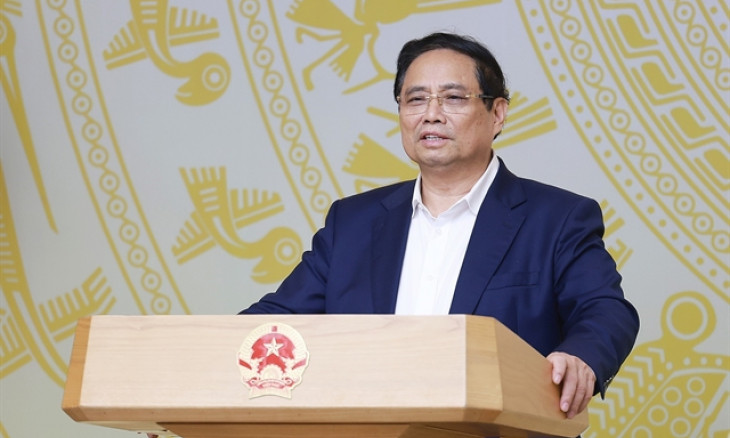Prioritising resources for the North-South high speed railway : Party
The high speed line is a crucial accelerator for the national economy, said Deputy Prime Minister Trần Hồng Hà.
Developing high-speed, urban railways and railways across Việt Nam will serve the national economy, according to Deputy Prime Minister Trần Hồng Hà.
The drive should be a catalyst for the mechanical, manufacturing and automation industries, among others, to serve the national economy and people's livelihoods, said the Deputy PM.
Hà was addressing reports on the progress of the North-South high speed rail project at the 10th session of the 13th Party Central Committee (PCC) yesterday in Hà Nội.
The PCC agreed to the policy of investing in the North-South project, identifying it as a political task and prioritising resources for early implementation.
Currently, the Ministry of Transport, relevant ministries, agencies, and units are urgently preparing a pre-feasibility report for the rail investment project, preparing the necessary procedures for submission to the National Assembly.
According to Deputy Minister of Transport Nguyễn Danh Huy, the project's objective is to build a high-speed railway line to meet transportation needs, contributing to the restructuring of transport market along the North-South corridor in an optimal and sustainable manner, creating a foundation and driving force for socio-economic development, and ensuring national defence and security.
The specific target is to approve the investment policy before 2025, clear the land, and start building before 2030, with the aim of completing the entire line before 2045.
The investment scope begins in Hà Nội at Ngọc Hồi Station, a hub for passenger and freight transport in the southern part of the capital's railway hub and ends in HCM City at Thủ Thiêm Station, a hub for passenger transport in the eastern part of HCM City's railway hub.
The project passes through 20 provinces and cities, including Hà Nội, Hà Nam, Nam Định, Ninh Bình, Thanh Hóa, Nghệ An, Hà Tĩnh, Quảng Bình, Quảng Trị, Thừa Thiên-Huế, Đà Nẵng, Quảng Nam, Quảng Ngãi, Bình Định, Phú Yên, Khánh Hòa, Ninh Thuận, Bình Thuận, Đồng Nai and HCM City.
To optimise transportation costs and take advantage of the strengths of each mode of transport, international experience, existing infrastructure capacity, projected transportation demand and the functionality of the North-South railway, the pre-feasibility study proposes the construction of a new double-track railway, with a 1,435mm gauge, electrified, designed for a speed of 350km per hour and a load capacity of 22.5 tonnes per axle, Huy said.
The total length is approximately 1,541km with 23 passenger stations and five freight stations.
The high-speed railway will transport passengers and meet dual-use requirements for national defence and security, while also being able to transport goods if necessary.
The existing North-South railway will be used for freight and short-distance passenger travel.
The high-speed railway will be constructed with 60 per cent of its length on bridges, 10 per cent in tunnels and 30 per cent on the ground.
At the meeting, leaders from the ministries of Planning and Investment, Finance, and Science and Technology discussed and clarified several groups of issues in the pre-feasibility report, which is being prepared for submission to the National Assembly in the upcoming session.
These issues include the project's investment scope, the economic efficiency of options for specialised passenger or combined passenger-freight services, and the comparison between investing in two segments versus the entire line.
Additionally, there were suggestions to apply special mechanisms and policies already in place for urban railways in Hà Nội and HCM City to the localities where the high-speed railway passes through.
Deputy Minister of Science and Technology Bùi Thế Duy proposed developing a list of specific technologies to be acquired, transferred, and mastered in the railway industry.
In conclusion, Deputy PM Hà requested the Ministry of Transport to continue following the PCC and the Politburo’s directives as well as opinions from ministries, sectors, experts, and the public into the pre-feasibility report.
The report should then be updated and completed for submission to the National Assembly, focusing on issues with scientific and practical foundations, Hà said.
Specifically, aside from the investment scope from the project's starting point to its endpoint, the Ministry of Transport should consider extending the high-speed railway line from Móng Cái City in Quảng Ninh Province to the southernmost Cà Mau Province.
"The Ministry of Transport should analyse the advantages and benefits of investing in the entire line, which would synchronise with other transport networks, compared to investing in just a few segments first,” the deputy PM told the meeting.
“The effectiveness of a high-speed railway specialised for passenger transport, or combined with freight transport when necessary, should be considered in terms of the overall economy, rather than being limited to the railway sector," he said.
Furthermore, the pre-feasibility report should reflect the view that the railway should be designed to achieve a straight alignment as much as possible, he added.
Regarding the method of investment implementation, the deputy PM asked the Ministry of Transport to clarify the advantages and disadvantages of treating the entire railway as a single project or multiple sub-projects.
He also proposed special mechanisms and policies for phased investment, central and local budget allocation in one go or every five years, the use of bonds, ODA, and other legitimate sources, and the utilisation of public debt limits.
Additionally, the Ministry of Transport should propose solutions to enhance decentralisation and assign responsibility for local authorities in preparing land and building technical infrastructure and stations.
Meanwhile, the Government would oversee the management of standards, design, infrastructure, vehicles, and information and operations systems as well as mobilise resources from private enterprises to reduce the State's costs.
"Special mechanisms and policies that have been applied to urban railways in Hà Nội and HCM City should be considered for the localities where the high-speed railway passes through," said Hà.
Hà also tasked the Ministry of Industry and Trade with co-ordinating with the Ministry of Transport, the Việt Nam Railway Authority, Việt Nam Railways and some enterprises to develop and implement a roadmap for technology acquisition, transfer and mastery in the railway industry.
These include the production of equipment, operation and management to ensure synchronisation and uniformity in technology, standards and regulations.
The Ministry of Education and Training, in coordination with the Ministry of Transport, should implement training programmes to prepare human resources capable of mastering technology, technical design, equipment manufacturing, operation and management in the railway sector.






